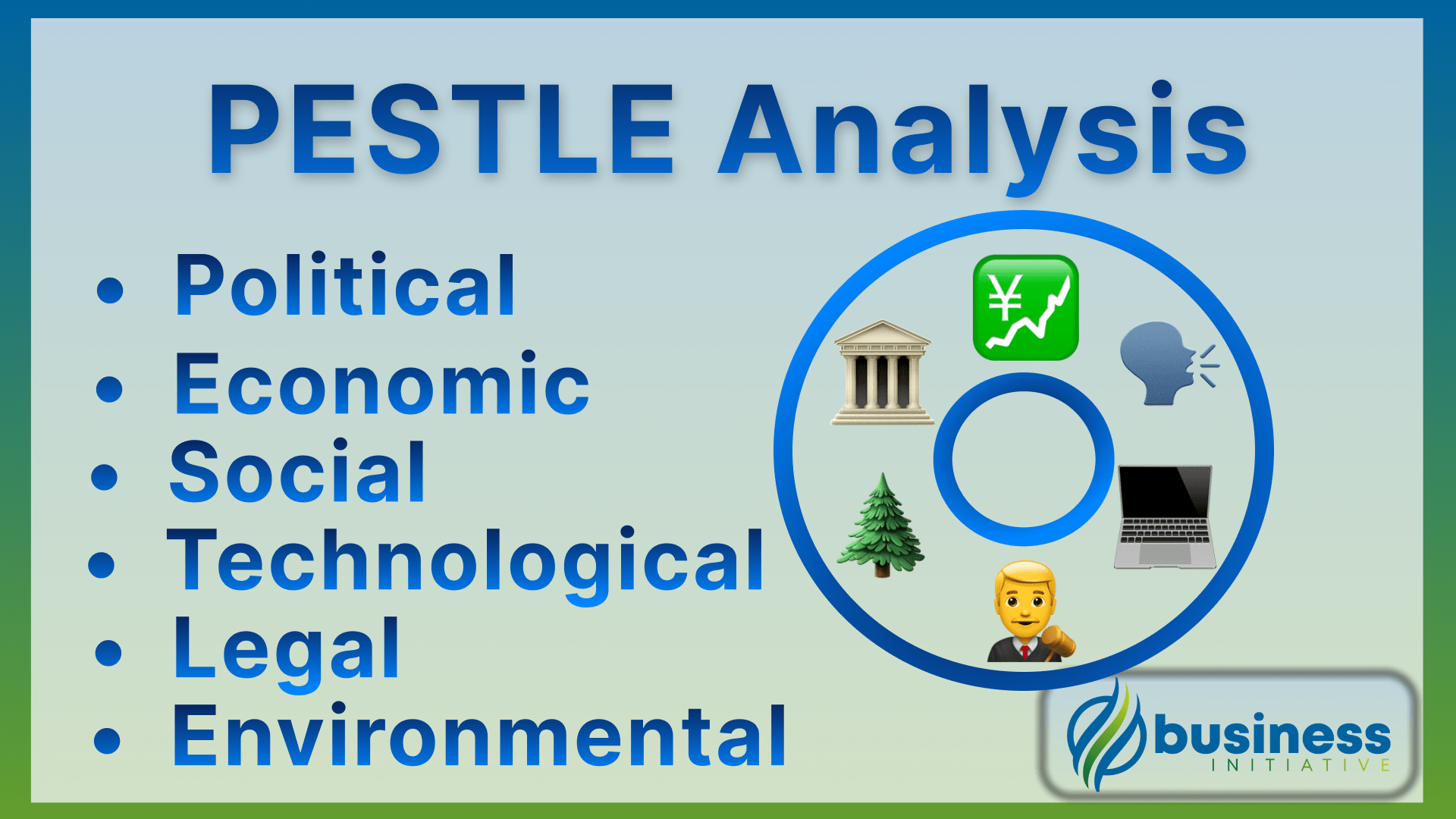PESTLE analysis is a strategic tool designed to help businesses grasp macro-environmental factors that influence their success.
It provides a comprehensive framework that helps companies proactively adapt to changes, and reveals opportunities within challenges.
By analyzing the political, economic, social, technological, legal, and environmental aspects of their environment, businesses can better position themselves in their market.
By using PESTLE analysis, business owners can predict and adapt to challenges in external environments while maintaining a positive, growth-oriented mindset.
 Key Takeaways
Key Takeaways
- PESTLE analysis assesses six key external factors—Political, Economic, Social, Technological, Legal, and Environmental—to understand how they impact business strategy.
- Tracking political and economic trends can help you anticipate changes in regulations or consumer behavior to adapt and seize new opportunities.
- Stay agile and adaptable because external factors, like COVID-19, can disrupt markets rapidly and challenge your existing business strategies.
- Cultivate a growth mindset to transform challenges like regulatory hurdles or technological disruption into opportunities for innovation and diversification.
- Viewing each PESTLE factor through a strategic lens uncovers new market potential, streamlines production, and ensures your business remains competitive.
A business that incorporates this analysis into its strategic planning can better withstand uncertainties and position itself for success.
This proactive approach enables a business to recognize threats and mitigate risks before they become detrimental.
 Table of Contents
Table of Contents
Benefits of Implementing PESTLE Analysis

1. Enhanced Decision-Making
The PESTLE framework equips business leaders to analyze each external factor methodically.
This systematic approach improves decision-making by offering comprehensive insights into the challenges and opportunities in the market.
For instance, with economic factors, leaders can devise strategies that are more resilient to inflation fluctuations, exchange rate volatility, or emerging global trends.
By keeping tabs on the political climate, they can anticipate new regulations and adjust their compliance or market strategies to align with future policy changes.
According to a Harvard Business Review article, decision-makers who use systematic frameworks like PESTLE craft strategies that help them stay prepared and adaptable.
2. Identifying New Opportunities
PESTLE analysis doesn’t just highlight risks; it illuminates hidden opportunities.
By identifying underserved market segments or shifting societal preferences, businesses can tailor their products to emerging consumer needs or explore geographical markets that remain untapped.
For example, Netflix utilized technological advancements and shifting consumer preferences toward streaming to pivot from DVDs to a digital-first strategy.
This early adoption led them to dominate the streaming market.
Research shows that businesses that capitalize on PESTLE data significantly improve their growth prospects.
3. Risk Mitigation
Recognizing potential external challenges early lets companies strategize and minimize future setbacks.
A legal shift in data protection regulations might pose a compliance risk for some, but for those that anticipate it, it is an opportunity to implement changes that strengthen their data governance practices.
When technological disruptions or economic downturns occur, businesses with contingency strategies adapt faster, reducing operational losses.
A Deloitte survey found that companies prioritizing proactive risk mitigation recovered 30% faster than those that didn’t.
4. Competitive Advantage
Knowing the intricacies of external influences helps businesses distinguish themselves from competitors.
With PESTLE insights, companies can refine their messaging to resonate with target customers and develop strategies that tap into emerging demands.
An example includes Tesla, which leverages the growing environmental awareness and government incentives for electric vehicles.
They have positioned themselves as an innovative leader in the market, offering a unique value proposition that connects deeply with their audience.
Competitive analysis using PESTLE gives businesses that edge in standing out amid saturated markets.
Conducting a Comprehensive PESTLE Analysis

A. Research and Data Collection
Start by collecting accurate and relevant data for each of the six PESTLE factors.
Look into government reports to understand upcoming political regulations or policies.
Consult economic forecasts from institutions like the International Monetary Fund (IMF) or World Bank to gauge global economic trends.
Analyze market research reports for technological advancements, industry-specific changes, and consumer behavior patterns.
Sociocultural studies can illuminate shifting societal attitudes that might impact customer preferences or workforce expectations.
With comprehensive and diverse sources, businesses develop a more nuanced understanding of external influences and their potential effects.
B. Analyzing Trends and Patterns
After gathering the data, identify trends and patterns that could affect both immediate and future business goals.
Comparative analysis helps businesses benchmark against competitors or industry averages to identify gaps or opportunities.
Predictive modeling can uncover correlations between macro-environmental changes and business performance.
For instance, a rise in fuel prices might reveal a direct impact on the cost of goods sold, requiring adjustments to pricing or logistics.
By mapping these relationships, businesses refine their strategies to stay aligned with external conditions.
C. Application to Strategic Planning
Incorporate PESTLE insights directly into strategic planning.
Use the analysis to identify risks, such as changing regulations that could impact product compliance, and adapt goals or timelines accordingly.
Look for emerging opportunities, like technological innovations or shifting consumer preferences, and integrate them into new business models.
By refining goals and pivoting business models, organizations maximize their strengths and turn potential challenges into growth opportunities.
For instance, companies that recognized the demand for remote work tools early shifted their models to meet new workforce needs, enabling rapid growth in the SaaS industry.
D. Regular Review and Adaptation
PESTLE analysis should not be a one-time exercise. External factors change quickly, and market shifts can rapidly disrupt strategic assumptions.
Regularly review and update the analysis to keep strategies relevant and flexible.
Encourage flexible strategic thinking across teams so they can pivot when new regulations emerge or market trends accelerate.
Resilient companies, like those that adapted during the COVID-19 pandemic, continued thriving by shifting their operations to new delivery models or rapidly adjusting their product lines to match changing demand.
Political Factors Overview

Definition and Overview:
Political factors, including government policies, taxation, and trade agreements, directly shape the business landscape.
Whether through policy shifts or regulatory changes, these factors significantly impact how businesses plan their strategies.
Political stability can determine market access and profitability, while uncertainty may force companies to adjust or withdraw from markets.
Trade policies, taxation, and regulations each present unique challenges and opportunities.
By understanding the implications of these factors, businesses can proactively align their strategies for success.
For instance, the U.S.-China trade war reshaped global supply chains, prompting companies to diversify their manufacturing operations to minimize risks.
Benefits of Knowing the Political Factors of Your Business:
1. Anticipating Political Trends:
When businesses accurately anticipate political trends, they can capitalize on favorable trade policies and enter new markets.
A notable example is the expansion of European companies into North American markets due to more favorable tariffs under the Comprehensive Economic and Trade Agreement (CETA).
2. Government Incentives:
Leveraging incentives can encourage innovation or sustainability initiatives that benefit businesses and the community.
For instance, many countries offer subsidies for renewable energy projects, reducing the financial burden on companies while fostering broader ecological benefits.
3. Regulatory Compliance:
Staying updated on regulatory changes ensures that businesses avoid penalties and maintain compliance.
This adherence builds trust with customers, stakeholders, and regulatory bodies, strengthening a company’s reputation in the market.
4. Market Opportunities:
Favorable trade policies and government incentives offer fresh opportunities for market expansion and innovation.
The Global Innovation Index shows that companies with government-backed research grants outperform those without due to access to broader resources and funding.
Actionable Insights:
- Monitoring:
Establish a robust system to monitor local and international political changes.
This proactive approach helps identify risks and opportunities early.
Businesses can subscribe to government bulletins, work with trade associations, or hire dedicated political analysts to ensure they’re well-informed.
- Stakeholder Engagement:
Cultivate strong relationships with policymakers and stakeholders.
This network provides valuable insights into potential regulatory shifts and allows businesses to influence outcomes.
Attend relevant industry conferences, contribute to policy discussions, and partner with government agencies to have a voice in shaping the policies that affect your industry.
Economic Factors Overview

Definition and Overview:
Economic factors like inflation, currency fluctuations, interest rates, and unemployment rates are vital macroeconomic trends that affect business operations.
Inflation directly influences consumer spending by raising or lowering the costs of goods and services.
Currency fluctuations can impact import-export businesses, either shrinking or expanding profit margins.
Interest rates govern the cost of borrowing, affecting capital investments, while unemployment rates shape consumer purchasing power and demand.
Businesses that understand these economic trends can make better strategic decisions, identifying opportunities in a challenging environment.
Benefits:
1. Resource Allocation:
Strategic resource allocation during economic fluctuations ensures businesses maintain flexibility and resilience.
By efficiently utilizing their assets during both economic upswings and downturns, businesses can respond to sudden changes.
During the 2008 financial crisis, companies with cash reserves could capitalize on lower investment costs and quickly pivot to high-demand products.
2. Pricing Strategy:
Adapting pricing strategies to match current economic conditions ensures profitability aligns with market demand.
Companies that factor in rising inflation adjust prices to keep up with costs while maintaining a competitive edge by offering unique value propositions.
3. Revenue Diversification:
Businesses that diversify revenue streams can better navigate changing consumer behavior and economic shifts.
For instance, food delivery companies thrived during the COVID-19 pandemic due to diversified revenue from B2C and B2B markets.
Actionable Insights:
- Scenario Planning:
Develop multiple scenarios to understand how potential market shifts might impact different revenue streams.
Predictive models that account for changes in inflation, interest rates, or consumer behavior help businesses design preemptive strategies.
- Adaptation:
Adapt to economic trends by focusing on high-demand products or optimizing pricing.
Luxury brands often maintain their pricing while releasing limited-edition products to capture a high-value market.
Consumer goods companies may offer discounts to capture a broader market share.
- Diversification:
Diversify product lines and markets to minimize risks from economic volatility.
This might involve launching different product ranges or entering new regions where demand remains strong.
Companies in the tech sector have broadened their reach internationally to cushion themselves from local economic downturns.
Social Factors Overview

Definition and Overview:
Social factors like demographics, lifestyle changes, and cultural attitudes significantly influence market demands and consumer behavior.
Demographic shifts such as aging populations or growing urbanization can reshape preferences and spending patterns.
Lifestyle changes driven by technological advancements or economic shifts may alter how customers interact with brands.
Cultural attitudes toward issues like sustainability, diversity, and ethical consumption heavily shape purchasing decisions.
Understanding these trends helps businesses adjust their products and strategies.
For instance, a study by Nielsen found that 73% of global consumers are willing to pay more for sustainable products.
Benefits:
- Market Segmentation:
By identifying evolving consumer behaviors, businesses refine their market targeting, creating tailored strategies for different segments.
For example, a fitness company might notice a trend toward at-home workouts and shift its messaging to promote home gym equipment and virtual training programs.
- Brand Loyalty:
Aligning brand messaging with prevailing social values strengthens identity and fosters deeper loyalty.
A brand that consistently communicates diversity and inclusion becomes synonymous with those values, attracting customers who prioritize them.
➤ MORE: Transform your business and enhance your customer loyalty today!
- Tailored Offerings:
Tailoring products for emerging customer segments allows businesses to tap into new opportunities and gain an edge.
In the tech world, companies develop specialized apps that target specific demographics like Gen Z or working parents, addressing niche needs and fostering customer loyalty.
- Relevance to Preferences:
Adapting to changing social preferences helps businesses stay relevant and capitalize on societal trends like sustainability.
Brands focusing on ethical sourcing and environmentally friendly packaging often attract a broader base of conscious consumers.
Actionable Insights:
- Trend Analysis:
Invest in research that identifies societal trends affecting your industry to better align with customer expectations.
Monitor market studies, conduct surveys, and partner with consumer research agencies to uncover key shifts.
- Corporate Social Responsibility (CSR):
Develop CSR initiatives that reflect customer values, reinforcing brand authenticity and improving public perception.
Patagonia, for instance, donates 1% of its sales to environmental causes, reinforcing its eco-friendly brand ethos while generating goodwill among customers who share those values.
➤ MORE: Create a CSR strategy just like the biggest brands!
Technological Factors Overview

Definition and Overview:
Technological factors include innovations like automation, AI, and data analytics, which can disrupt or enhance business practices.
Automation streamlines operations, while AI delivers smarter decision-making and personalization.
Data analytics offers deep insights into customer behavior, market trends, and performance metrics, allowing companies to refine strategies.
Understanding the role of these technologies is crucial, as businesses that adopt them early gain a significant competitive edge.
For example, according to McKinsey, businesses that integrate AI into their workflows can boost productivity by up to 40%.
Benefits:
1. Operational Efficiency:
Automating key processes improves productivity and reduces costs, leading to leaner and more agile operations.
In manufacturing, robotic automation can minimize errors, cut production times, and improve safety.
Retailers that implement chatbots for customer service can handle high volumes of inquiries efficiently without overburdening staff.
2. Customer Experience:
Using AI and machine learning for personalization strengthens customer loyalty and differentiates businesses.
For instance, Amazon’s recommendation engine analyzes user behavior to suggest relevant products, leading to increased customer satisfaction and repeat purchases.
3. Early Adoption:
Early adoption of relevant technologies ensures businesses maintain a competitive position, streamline operations, and deliver superior customer experiences.
Netflix’s early pivot to a digital-first model made it a dominant player in the streaming industry when other companies struggled to catch up.
4. Market Differentiation:
Leveraging innovations like predictive analytics and AR/VR improves efficiency, customer satisfaction, and market differentiation.
Retailers incorporating AR/VR create immersive shopping experiences, while predictive analytics enable marketers to craft targeted campaigns.
Actionable Insights:
- Investment Roadmap:
Develop a strategic technology investment roadmap that aligns with business goals and market trends.
It ensures sustainable growth and provides a clear direction for technological implementation.
Gartner recommends prioritizing customer-centric technologies and cybersecurity to maximize ROI.
Foster an agile culture that quickly adopts emerging technologies.
An agile environment encourages innovation and swift adaptation to technological trends, helping businesses remain responsive to market changes.
Legal Factors Overview

Definition and Overview:
Legal factors include industry regulations, labor laws, and intellectual property rights that influence business operations.
For instance, data protection regulations like the General Data Protection Regulation (GDPR) have reshaped how companies collect and process consumer data.
Labor laws set standards for employee rights, wages, and benefits, while intellectual property rights safeguard innovations.
Compliance with these regulations minimizes risks and maximizes strategic opportunities, such as gaining market access or protecting trade secrets.
A PwC report reveals that non-compliance penalties can cost businesses up to 4% of their global annual revenue.
Benefits:
1. Risk Mitigation:
Staying compliant with legal requirements significantly reduces the risk of penalties, lawsuits, and reputational damage.
Companies that follow international data protection laws avoid costly fines, which can reach up to $20 million for serious violations under GDPR.
2. Competitive Advantage:
Adapting early to changing laws provides a strategic edge.
Businesses that adhere to or exceed regulations streamline their processes, turning compliance into a competitive advantage.
Brands that proactively meet ethical sourcing standards and fair labor practices build stronger trust with customers and investors.
3. Brand Reputation and Trust:
By prioritizing proactive compliance, companies establish their brand as ethical and transparent, fostering trust with stakeholders.
Compliance with environmental laws or labor rights reflects positively on corporate social responsibility (CSR), influencing customer perception and loyalty.
Actionable Insights:
- Legal Audits:
Conduct regular legal audits to identify potential compliance gaps and address them early.
An audit can uncover outdated policies or practices that need updating.
Implementing regular audits ensures adherence to current standards and prepares businesses for sudden changes.
Collaborate with legal experts to receive ongoing guidance and maintain compliance amid evolving regulations.
Partnerships with legal advisors or in-house legal teams help monitor regulatory changes, interpret complex laws, and navigate international standards.
Environmental Factors Overview

Definition and Overview:
Environmental factors encompass issues like climate change, waste management, and environmental regulations, which all influence business practices.
The growing emphasis on sustainable practices pushes companies to adopt greener strategies to minimize their ecological footprint.
Changes in consumer behavior, combined with tightening regulations around emissions and resource consumption, make sustainability a priority.
Understanding these factors allows businesses to adopt models that ensure efficiency and long-term viability.
For instance, global temperature increases have led to stricter carbon emissions regulations, pushing businesses to invest in renewable energy sources.
Benefits:
1. Sustainability Branding:
Promoting environmentally conscious practices strengthens brand positioning and resonates with eco-conscious consumers.
A Nielsen study found that 66% of global consumers are willing to pay more for brands committed to sustainability.
Companies that align their practices with eco-friendly values see stronger customer loyalty.
2. Long-Term Viability:
Reducing the ecological footprint ensures business longevity by enabling adaptability to changing regulations.
For example, automakers shifting to electric vehicles (EVs) gain a foothold in an evolving market that increasingly favors low-emission options.
3. Growth Opportunities:
Offering eco-friendly products or services creates opportunities for growth by appealing to markets where sustainability is prioritized.
Companies like Unilever report that their “Sustainable Living” brands grow 69% faster than other business lines.
4. Profitability and Competitiveness:
Reducing environmental impact through innovative strategies boosts profitability by cutting waste and increasing energy efficiency.
Patagonia’s use of recycled materials and sustainable manufacturing practices cut production costs while reinforcing brand authenticity.
Actionable Insights:
- Green Initiatives:
Invest in green technologies and sustainable practices to minimize environmental impact and appeal to eco-conscious markets.
Implementing renewable energy sources or minimizing packaging waste can enhance corporate social responsibility (CSR) initiatives.
- Circular Economy:
Adopt a circular economy model through recycling, reuse, and resource optimization.
This maximizes resource efficiency and reduces costs by extending the lifecycle of materials.
For instance, IKEA aims to be fully circular by 2030, reusing resources across its product lines.
FAQs - Frequently Asked Questions About the PESTLE Analysis

What is PESTLE analysis?
PESTLE analysis is a strategic tool that examines external factors affecting a business.
Learn More...
PESTLE analysis stands for Political, Economic, Social, Technological, Legal, and Environmental analysis.
It helps businesses identify how macro-environmental factors influence their strategies and operational effectiveness.
By understanding these external factors, companies can make informed decisions to enhance their competitive advantage and adapt to changing market conditions.
Why is PESTLE analysis crucial for business strategy?
It identifies external influences that can impact business success and helps in strategic planning.
Learn More...
PESTLE analysis provides a comprehensive overview of the macro-environmental factors that might affect business operations and growth.
- Political stability, economic conditions, and legal regulations are assessed to forecast potential risks and opportunities.
- Social trends and technological advancements can unveil new markets or necessitate changes in product development.
- Environmental factors push companies towards sustainable practices, influencing public perception and compliance.
Incorporating this analysis into business planning helps companies preemptively address challenges and leverage emerging opportunities for sustained growth.
How can PESTLE analysis enhance decision-making?
It offers a structured approach to understanding external environments, improving strategy formulation.
Learn More...
By systematically evaluating each PESTLE factor, businesses can pinpoint specific external threats and opportunities.
This methodical approach enhances the quality of strategic decisions by grounding them in comprehensive external data analysis.
For example, understanding economic indicators like inflation or interest rates helps businesses adjust their financial strategies accordingly, leading to better resource allocation and risk management.
What are some real-world examples of PESTLE analysis impacting business?
Netflix's shift to streaming and Tesla's focus on electric vehicles are outcomes of effective PESTLE analysis.
Learn More...
Netflix recognized technological changes and consumer preferences shifting towards online streaming, allowing them to pivot from DVD rentals to dominate the streaming service market.
Tesla leveraged environmental factors by focusing on electric cars in response to growing environmental awareness and regulatory incentives for lower emissions.
- Both companies used insights from PESTLE factors to innovate and reposition themselves strategically in their respective markets.
Can PESTLE analysis predict market disruptions like COVID-19?
PESTLE analysis helps businesses prepare for disruptions by understanding and monitoring external factors.
Learn More...
While specific events like COVID-19 are difficult to predict, PESTLE analysis can help companies build resilience by identifying potential vulnerabilities in their external environment.
For instance, analyzing economic and social factors can help businesses develop contingency plans for supply chain disruptions or shifts in consumer behavior.
Regular updates to PESTLE analysis ensure that businesses remain agile and can respond quickly to unforeseen market changes.
How often should a business conduct PESTLE analysis?
Regularly, ideally annually or whenever major market or geopolitical changes occur.
Learn More...
Conducting PESTLE analysis on a regular basis helps businesses stay updated with external changes that could affect their strategies.
An annual review aligns with most strategic planning cycles, allowing companies to adjust their long-term plans accordingly.
During periods of significant change, such as new government regulations or major economic shifts, more frequent reviews can help businesses remain agile and responsive.
What are the common challenges in implementing PESTLE analysis?
Identifying relevant data sources and interpreting vast amounts of information can be challenging.
Learn More...
Collecting accurate, timely, and comprehensive data for each PESTLE factor often requires access to diverse information sources, which can be resource-intensive.
Interpreting this data to discern its implications for the business requires skilled analysis and may involve subjective judgment.
- Businesses may struggle with the bias in source material, varying quality of data, and keeping the analysis objective and actionable.
- Collaborating with analysts who specialize in external market factors can help mitigate these challenges and improve the quality of insights derived from the PESTLE analysis.
How does PESTLE analysis differ from SWOT analysis?
PESTLE focuses on external factors, while SWOT also includes internal strengths and weaknesses.
Learn More...
PESTLE analysis is used to understand the macro-environmental external factors that impact a business, categorized into Political, Economic, Social, Technological, Legal, and Environmental segments.
SWOT analysis, on the other hand, assesses internal capabilities (Strengths and Weaknesses) and external opportunities and threats, providing a broader overview of both internal and external business environments.
Combining both analyses gives a more holistic view of a company's strategic landscape, helping to align internal resources with external opportunities and challenges.
In Summary…
A comprehensive PESTLE analysis enables businesses to proactively anticipate challenges and uncover opportunities.
By examining the political, economic, social, technological, legal, and environmental factors in detail, companies can align their strategies with market realities and make informed decisions.
This framework guides leaders through the complexities of external factors, leading to resilient and data-driven business planning.
External challenges aren’t barriers—they’re opportunities for growth, innovation, and adaptability.
Viewing the business environment with an abundance mindset turns risks into avenues for strategic flexibility and positive transformation.
Businesses that engage fully in PESTLE analysis can build resilience, maintain relevance, and capitalize on emerging market trends.
Now is the time to take the first step toward integrating PESTLE analysis into your strategic planning.
Schedule a consultation call to get expert advice on tailoring strategies that align with your market’s unique challenges.
We will walk you through how each factor applies to your business, offering personalized insights that position you for success.
Need help implementing PESTLE analysis into your business?
Use our contact form to access resources that will guide your journey.
We provide practical tools, detailed guides, and real-world examples that show how each factor can influence your strategic decisions.
Don’t miss out on the opportunity to elevate your business!
Subscribe to our newsletter to receive curated industry insights, PESTLE analysis trends, and expert tips straight to your inbox.
Follow us on X (Twitter) for real-time updates, thought leadership, and interactive discussions with like-minded business leaders.
Sources and Additional Resources
- Investopedia - "PEST Analysis"
- Forbes - "How to Conduct a PESTLE Analysis"
- Harvard Business Review - "Strategic Decision Making"
- Deloitte - "The Risk Intelligent Enterprise"
- International Monetary Fund (IMF) - "World Economic Outlook"
- World Bank - "Global Economic Prospects"
- upmetrics - "How to Conduct a PESTLE Analysis Explained with Example"
- House of Commons Library - "CETA: the EU-Canada free trade agreement"
- World Intellectual Property Organization - "Global Innovation Index 2023"
- International Monetary Fund - "Financial Development Index Database"
- World Bank - "Global Economic Prospects during COVID-19"
- Nielsen - "2023 ESG Report"
- Forbes - "Loyalty Programs: The New Pillar For Next-Gen Customer Engagement"
- McKinsey - "Generative AI: How will it affect future jobs and workflows?"
- Gartner - "Top 10 Strategic Technology Trends for 2024"
- PwC - "2019 State of Compliance Study"
- Deloitte - "Navigating regulatory change for emerging technologies"
- Nielsen - "Consumers care about sustainability"
- Unilever - "Unilever celebrates 10 years of the Sustainable Living Plan"


